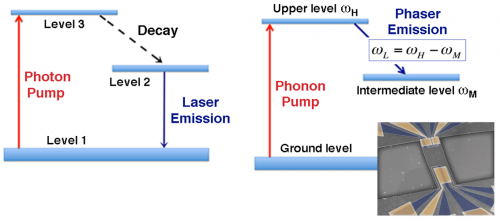March 19, 2013 report
Researchers build fully mechanical phonon laser

(Phys.org) —Researchers working at Japan's NTT Basic Research Laboratories have successfully built an all mechanical phonon laser. In their paper published in Physical Review Letters, the team describes how they built a phonon laser without using any optical parts by basing it on a traditional optical laser design.
The world has grown accustomed to lasers, they're a part of modern life, from DVD players to cash registers at the grocery store—lasers are everywhere. One thing they all have in common, is that they are based on photon emissions. There are other kinds of similar devices, of course, such as masers, which are based on microwave radiation, but they are not as well known. More lately, research has focused on lasers based on sound, which would emit phonons (lattice vibrations) instead of photons, an idea that's been thrown around for several years, but hasn't gotten much traction because the uses for such a laser are still unclear.
Back in 2010 a team of researchers succeeded in building a phonon laser (or phaser, as some have taken to calling it) but it relied on the use of an optical laser. In this new effort, the research team has built a phonon laser that is purely mechanical, which the team says, should make it easier to implement in other systems should a reason for doing so be found.
Photon lasers work by exciting electrons in a crystal or gas, then allowing them to revert to a more relaxed state. When they do so, a certain wavelength of light is released which is focused using mirrors.
To build their phonon laser, the team followed the same basic design—a mechanical oscillator excites some amount of phonons, which are then allowed to revert back to a relaxed state. But the energy is still in the system—it causes the device to vibrate at a desired frequency within a very narrow wavelength, making it a lasing device. The entire laser has been etched onto a single integrated circuit.
While researchers still aren't clear to what purpose such a laser might be put, especially in light of the fact that phonons require a transmission medium to work, that hasn't stopped them from proceeding. When the photon laser was first developed, no one knew what to do with it either. The researchers suggest that phonon lasers might be used to build a tiny clock, or as part of ultrasound machines or even as a very highly accurate measuring device.
More information: Phonon Lasing in an Electromechanical Resonator, Phys. Rev. Lett. 110, 127202 (2013) DOI:10.1103/PhysRevLett.110.127202
Abstract
An electromechanical resonator harboring an atomlike spectrum of discrete mechanical vibrations, namely, phonon modes, has been developed. A purely mechanical three-mode system becomes available in the electromechanical atom in which the energy difference of the two higher modes is resonant with a long-lived lower mode. Our measurements reveal that even an incoherent input into the higher mode results in coherent emission in the lower mode that exhibits all the hallmarks of phonon lasing in a process that is reminiscent of Brillouin lasing.
Journal information: Physical Review Letters
© 2013 Phys.org



















